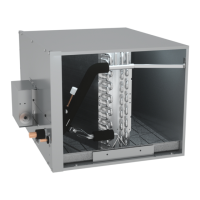7
A quenching cloth is strongly recommended to prevent scorching
or marring of the equipment finish when brazing close to the
painted surfaces. Use brazing alloy of 2% minimum silver content.
Refrigerant gas may produce toxic gas if it comes into contact with
fire (as from a heater, stove or cooking device). Exposure to this
gas could cause severe injury or death.
Applying too much heat to any tube can melt the tube. Torch heat
required to braze tubes of various sizes must be proportional to
the size of the tube.
Service personnel must use the appropriate heat level for the size
of the tube being brazed.
When brazing the refrigerant piping, perform nitrogen
replacement first or perform the brazing while feeding nitrogen
into the refrigerant piping. See following figure.
When brazing pipes while feeding nitrogen inside the piping,
make sure to set the nitrogen pressure to 2.9 PSI or less using the
pressure reducing valve.
Use of oxygen could result in an explosion resulting in serious
injury or death. Use only dry nitrogen gas.
Refrigerant piping
Part to be brazed Taping
Pressure-reducing valve
Hands
valve
Nitrogen
Nitrogen
Figure 9
NOTE: Do not use flux when brazing refrigerant piping. Therefore,
use the phosphor copper brazing filler metal (BCuP) which does
not require flux. Flux has an extremely negative effect on refriger-
ant piping systems. For instance, if chlorine based flux is used, it
will cause piping corrosion. Flux containing fluorine will damage
refrigerant oil.
8.5 Re-assemble the Coil and Controls
• Once heat from the brazed area has dissipated, route com-
ponent wiring back through the bottom front panel wire-
way.
• Reinstall the tubing grommets and close the top and bot-
tom front panels.
• Re-install the control panel to the top and bottom front
panel using mounting location holes and factory supplied
screws.
• Reconnect Control Panel wiring to component wiring.
• After the work is finished, make sure to check that there is
no gas leak.
• After checking for gas leaks, be sure to insulate the piping
connections as shown in Figure 10.
Completely insulate gas refrigerant piping in order to prevent con-
densation and possible water damage. Failing to insulate the pipes
may cause leaking or burns. Be sure to use insulation which can
withstand temperatures of 250° F (120° C) or more. Reinforce
the insulation on the refrigerant piping acording to the installa-
tion environment. If environmental conditions reach 86°and 80%
RH, condensate may form on the surface of the insulation. To
prevent condensate leakage, reinforce the refrigerant piping in-
sulation according to the installation environment.
Do not leave a gap
Gas piping
Piping heat insulation
materia
l
Cased
Coil
Figure 10
• Do not allow component wiring to become pinched. Failure
to do so may le ad to u ni t fa ilure.
• Be sure to insulate gas piping all the way (required insulation),
to piping connection inside the unit. Any exposed piping may
cause condensation or burns if touched.

